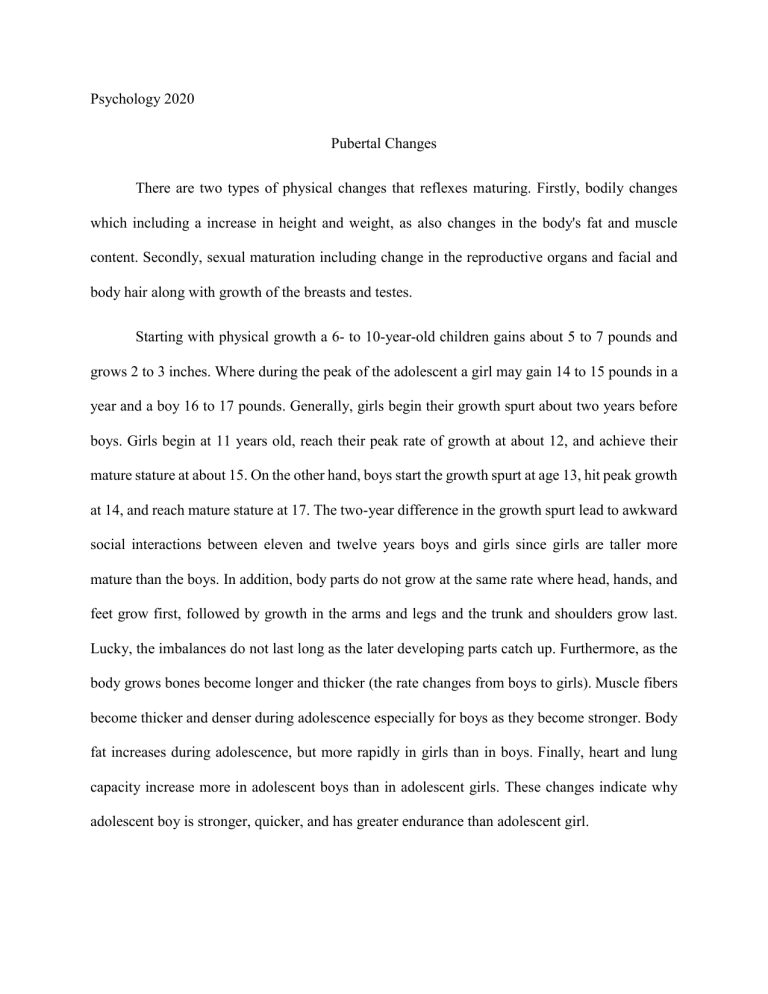
Psychology 2020 Pubertal Changes There are two types of physical changes that reflexes maturing. Firstly, bodily changes which including a increase in height and weight, as also changes in the body's fat and muscle content. Secondly, sexual maturation including change in the reproductive organs and facial and body hair along with growth of the breasts and testes. Starting with physical growth a 6- to 10-year-old children gains about 5 to 7 pounds and grows 2 to 3 inches. Where during the peak of the adolescent a girl may gain 14 to 15 pounds in a year and a boy 16 to 17 pounds. Generally, girls begin their growth spurt about two years before boys. Girls begin at 11 years old, reach their peak rate of growth at about 12, and achieve their mature stature at about 15. On the other hand, boys start the growth spurt at age 13, hit peak growth at 14, and reach mature stature at 17. The two-year difference in the growth spurt lead to awkward social interactions between eleven and twelve years boys and girls since girls are taller more mature than the boys. In addition, body parts do not grow at the same rate where head, hands, and feet grow first, followed by growth in the arms and legs and the trunk and shoulders grow last. Lucky, the imbalances do not last long as the later developing parts catch up. Furthermore, as the body grows bones become longer and thicker (the rate changes from boys to girls). Muscle fibers become thicker and denser during adolescence especially for boys as they become stronger. Body fat increases during adolescence, but more rapidly in girls than in boys. Finally, heart and lung capacity increase more in adolescent boys than in adolescent girls. These changes indicate why adolescent boy is stronger, quicker, and has greater endurance than adolescent girl. Secondly, brain growth where in adolescence the brain is about 95% of the size and weight of an adult's brain. There are two features of brain development that begin early in life are nearly complete in adolescence. The first feature is myelination which makes the adolescents ability to process information more efficiently than the child. Another feature is some parts of brain regions reach maturity. Brain systems which are sensitive to reward can reach maturity in adolescence but the other systems such as ones responsible for self-control are not fully specialized until adulthood. This could lead adolescence to do behaviors involve risk, because the rewards of risky behavior sometimes swamp the adolescent's ability to suppress the desire to engage in such activities. This makes adolescents vulnerable to high-risk activities Lastly, sexual maturation which refers to change in primary sex characteristics. That include the ovaries, uterus, and vagina in girls and the scrotum, testes, and penis in boys. It also includes changes in secondary sex characteristics. That shows the growth of breasts and the widening of the pelvis in girls, the appearance of facial hair and the broadening of shoulders in boys, and the appearance of body hair and changes in voice and skin in both boys and girls. For girls and boys puberty occurs at about age 13. For girls, puberty begins with growth of the breasts and sequence the growth spurt, followed by the appearance of pubic hair. On the other hand, in boys puberty commences with the growth of the testes and scrotum, then the appearance of pubic hair, the start of the growth spurt, and growth of the penis. The pituitary gland helps to regulate physical development by releasing growth hormone. Also, the pituitary regulates pubertal changes by signaling other glands to secrete hormones. In early elementary school the pituitary signals the adrenal glands to release androgens to grow body hair. Years later, girl’s pituitary’s signal the ovaries to release estrogen, which causes the breasts to enlarge, the female genitals to mature, and fat to accumulate. In boys, the pituitary signals the testes to release the androgen hormone testosterone, which causes the male genitals to mature and muscle mass to increase. Estrogen and androgen are present in both boys and girls, but estrogen is released more in girls and androgen is released more in boys. The timing of pubertal events is regulated partially by genetics. For example, a mother's age at menarche is related to her daughter's age at menarche. However, the genetic forces are strongly influenced by the environment especially an adolescent's nutrition and health. Meaning that puberty is more likely to occur earlier in adolescents who eat healthy and practices sports than ones that don’t. The social environment also influences puberty usually for girls. As menarche occurs at younger ages in girls who experience chronic stress or harsh punishment, or who are depressed because stress may release hormones that activate the hormones that trigger menarche. Teenagers are aware of the changes taking places in their bodies which affects adolescents' psychological development. Firstly, body image where adolescents are often concerned about their overall appearance, and they look frequently at the mirror to spot any changes in their body. In general, girls worry more than boys about appearance and are more likely to be dissatisfied with their appearance and they spend a quality time comparing their own appearance with that of their peers. On the other hand, boys do not get such a influence from their peers but they are unhappy with their appearance when they expect to have an idealized strong, muscular body but do not. Most adolescent girls today are well educated about menstruation beforehand often from discussions with their mothers. In addition, most girls are moderately pleased because it is a new sign of maturity but irritated by the inconvenience and messiness of menstruation. Girls usually tell their moms about menarche right away, and after two or three menstrual periods, they tell their friends. In some countries this event is celebrated. On the other hand, boys know about spontaneous ejaculations beforehand, and they get their information by reading not from parents. When boys are prepared for spermarche, they feel more positively about it and rarely tell their parents. Secondly, moodiness where adolescents are moody, but this is not due primarily to hormone. Rapid increases in hormone levels are associated with greater irritability and greater impulsivity. However, the correlations are small and are found primarily in early adolescence. Teenagers' moodiness reflects frequent changes in their activities and social settings. Teenagers tend to do many activities in their day. For example, they tend to be in a good mood when they hangout with friends and in a bad mood when they are at classroom or at work. Because adolescents change activities and social settings many times in a single day, they appear to be moodier than adults which shows that it is not associated with hormones. Although puberty begins at age 10 in the average girl and age 12 in the average boy many boys and girls can hit it month or years before or after the normal age. An early-maturing boy might begin puberty at age 11, whereas a late maturing boy might start at 15 or 16. On the other side, an early maturing girl might start puberty at age 9: a late-maturing girl, at 14 or 15. Girls who mature early can have lack self-confidence, are less popular, are more likely to be depressed and have behavior problems, in addition they are more likely to smoke and drink. Early maturing girls are also more likely to have relationships with older boys which could lead them to be pressured into sex and become mothers while still teenagers. However, as adults, they typically have less prestigious and lower-paying jobs. These bad scenarios of early maturing girls are more likely to happen when they live in poverty or experience harsh punishment from parents not in a supportive, warm, and lovely family. Maturing early can be harmful for boys as well . Early maturing boys are likely to have psychological disorders such as depression, also they are more prone to substance abuse and to sexual activity. Being more mature than what they should be at their age may cause early maturing boys to have problems with their peers who have not yet matured and cause them to spend more time with older boys. That can cause them to be depressed and more likely to do risky behaviors, but they are less likely to have these problems compared to girls early maturing problems. Maturing late have less bad consequences for girls and boys. Late maturing girls fare well. In the other hand, late maturing boys are at somewhat greater risk for depression.


